Massie Wireless Station
The Massie Wireless Station (PJ) was built in Point Judith, Rhode Island, in 1907 and may be the oldest surviving working wireless station in the world.[2][3][4][5] It is named for inventor Walter W. Massie, president of the Massie Wireless Telegraph Company.[6] The structure was moved to the New England Wireless and Steam Museum in 1983 where it is preserved as a technology museum and historic site.[7]
Massie Wireless Station | |
 The station at its current location | |
  | |
| Location | 1300 Frenchtown Road East Greenwich, Rhode Island |
|---|---|
| Coordinates | 41°37′26.78″N 71°30′45.43″W |
| Built | 1907 |
| NRHP reference No. | 01001157 [1] |
| Added to NRHP | October 22, 2001 |
History

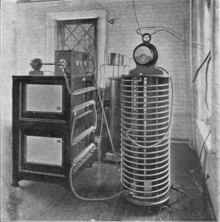
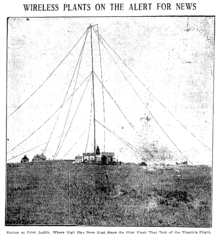
In December 1902 the American De Forest Wireless Telegraph Company setup an earlier station in an existing house on a beach near Point Judith Light and another near Block Island Southeast Light, 15 miles (24 km) from the coast.[9] By May 1903 they had successfully exchanged test messages.[10] Messages were sent using Morse code.[11] The stations were initially operated for the Providence Journal to send news stories to the island to be printed locally. Another goal was that passing ships could also send messages to the mainland which would then be relayed to Providence or New York City by telephone arriving hours before the ships reached port. At this time few places in the world were passed by so many ships as Block Island.[9] The Block Island Wireless began publishing in July.[12][13] At the time it was one of only two daily newspapers that printed dispatches sent by wireless.[lower-alpha 1][14] The stations soon began sending messages (called "aerograms") for the public and charging a fee for the service.[15] Initially, this experimental wireless service was only intermittently successful and the Block Island Wireless ceased publication at the end of August.[11][12]
The Journal, dissatisfied with the operation, offered management of the two stations to the recently formed Massie company.[11][16] By 1904 the new equipment installed by Massie to replace the de Forest system enabled reliable two-way communication between the island and the mainland.[11] The stations also provided communications to passenger steamships, particularly those of the Fall River Line.[17] When Massie equipped the steamship Plymouth with wireless it was the first Long Island Sound steamer to have this capability. A Massie employee was stationed on the ship as the wireless operator. During initial tests the coast station was able to communicate with the ship at a distance of 33 miles (53 km). The crews on these ships considered Point Judith to be a dangerous point on this route. The shore station would advise them of adverse weather conditions such as fog hours before they reached it. The station would then aide in navigation as it passed.[18] By 1905 with improvements to the station at Block Island it was able to detect signals from approaching ocean liners beyond the Nantucket Shoals Lightship 66 – a distance of 150 miles (240 km).[19]
In 1907 Massie upgraded the Point Judith station by constructing a new building, the one that is preserved today, on the same site. The spark-gap transmitter operated at up to 2 kW power and was connected to an antenna tower that was 300 feet (91 m) tall.[20] The wavelength[lower-alpha 2] of transmission was listed as 400 metres (750 kHz) in 1907 and 325 metres (920 kHz) in 1912.[22][23]
Wireless operators at the station kept a vigil in April 1912 listening for news from rescue vessels about the sinking of the RMS Titanic.[24] Ownership of Massie's stations were then transferred to Marconi's Wireless Telegraph Company in August 1912. The sale include all shore and ship stations along with the contracts that the business held. Massie retained the rights to his patents and continued to maintain a shop with his laboratory equipment.[25][26] The Point Judith station ceased operation shortly after that.[lower-alpha 3] At the time it was shut down it had a range of up to 500 miles (800 km).[27] The building then became a Western Union landline telegraph station until World War II. In subsequent decades it was used as a summer house.
Other stations
The two original stations were joined by others to form a system along the southern coast of New England. Massie operated other stations farther south along the east coast. The Point Judith station identified using the call letters "PJ". Other stations (and their call letters) that were part of the Massie system included:
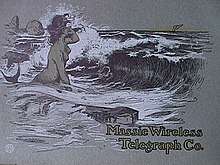
| Location | Call |
|---|---|
| Chatham, Massachusetts | AU |
| Block Island, Rhode Island | BI |
| Cape May, New Jersey | CP |
| Providence, Rhode Island | HG |
| Jacksonville, Florida | JX |
| Point Judith, Rhode Island | PJ |
| Wilson's Point at Norwalk, Connecticut | WN |
| New London, Connecticut | WS |
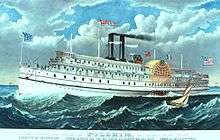
| Steamship | Call |
|---|---|
| Priscilla | CA |
| Pilgrim | GM |
| Chester W. Chapin | HN |
| Providence | PV |
| Plymouth | PX |
| City of Lowell | WE |
Gallery
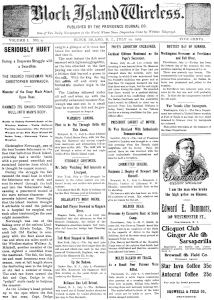 Second issue of the Block Island Wireless, July 10, 1903.
Second issue of the Block Island Wireless, July 10, 1903.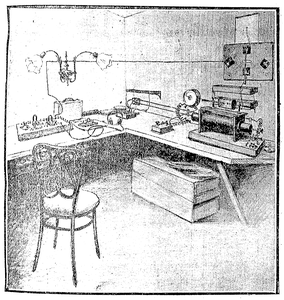 Massie wireless telegraph system on the steamer Plymouth, 1904.
Massie wireless telegraph system on the steamer Plymouth, 1904.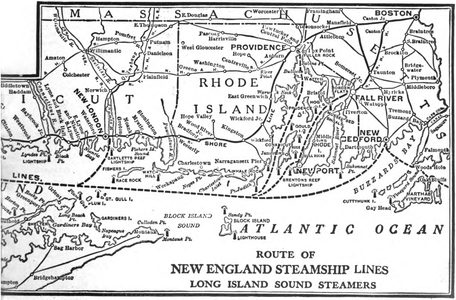 Steamship routes. The first two Massie coast stations were near the Pt. Judith and southeast Block Island lighthouses.
Steamship routes. The first two Massie coast stations were near the Pt. Judith and southeast Block Island lighthouses. Portrait of Walter W. Massie, 1910.
Portrait of Walter W. Massie, 1910.
Preservation

In 1983 the building was moved to the New England Wireless and Steam Museum in East Greenwich, Rhode Island, to avoid demolition.[7][29] The former site is now part of Roger Wheeler State Beach. The station is now situated within the Tillinghast Road Historic District, of which it is listed as a non-contributing building.
Another building at the Museum contains a collection of historic telegraph, radio, and television equipment.[30] The original equipment from the station was donated to the Museum by Massie's family. The transmitter is functional and now operates at 850 metres (350 kHz) though it is not connected to an antenna.[20][31] The station was added to the National Register of Historic Places in 2001.[1] The Massie Wireless Club began amateur radio operation from the station in 2018 using the club call sign N1EPJ.[32]
See also
- Archie Frederick Collins – Massie's company merged with Collin's company in 1909, though the arrangement soon ended.
Notelist
- The other was The Wireless published on Santa Catalina Island by the Los Angeles Times starting in March 1903.
- Documents from this era listed the wavelength of the station instead of the equivalent radio frequency as is common today. That convention is followed in this article. The wavelength/frequency is only approximate due to the 50 kHz wide[21] bandwidth of a spark-gap transmission.
- The United States Radio Law of August 13, 1912 prohibited spurious emissions of the type that are characteristic of spark-gap transmissions.[21]
References
- "National Register Information System". National Register of Historic Places. National Park Service. January 23, 2007.
- Petersen, Julie K. (8 October 2018). The Telecommunications Illustrated Dictionary. CRC Press. p. 1187. ISBN 978-1-351-83611-1. Retrieved 9 December 2019.
- Ziner, Karen Lee (6 December 1998). "Engine 'rescue' honors our engineering heyday". Providence Sunday Journal. p. A-01.
- Emmerson, Andrew (1998). Electronic Classics: Collecting, Restoring and Repair. Elsevier. p. 312. ISBN 978-0-08-050528-2.
- Kandarian, Paul E. (2 October 2011). "History is one center of busy waterfront town". Boston Globe. p. G.23.
- Chapple, Joe Mitchell, ed. (June–July 1910). "Merging the Wireless Companies". National Magazine. Vol. XXXII no. Three. pp. 425–429. Retrieved 28 November 2019.
- Houlihan, J. V. (May 18, 2013). "Tap, tap, tap". Block Island Times. p. 10. Retrieved 12 January 2020.
- "Wireless Telegraphy". Providence Journal. April 2, 1904. p. 12.
- "New Wireless Telegraph Station". New York Tribune. 16 December 1902. p. 6.
- "Doubting Thomas Convinced". Providence Journal. May 7, 1903. p. 3.
A doubting Thomas on Block Island was convinced yesterday that messages could pass through the air without the aid of wires.
- F.H.Y. (January 26, 1942). "Block Island Wireless". Providence Journal. p. 9.
- Arceneaux, Noah (September 1, 2014). "The Ecology of Wireless Newspapers: Publishing on Islands and Ships, 1899-1913". Journalism & Mass Communication Quarterly. 91 (3): 562–577. doi:10.1177/1077699014538826.
- "A 'Wireless' Newspaper". Providence Journal. June 25, 1903. p. 1.
- "Another Wireless Paper". Los Angeles Times. July 7, 1903. p. A7.
- "Aerograms to Block Island". Providence. July 17, 1903. p. 12.
- "Walter W. Massie, Pioneer In Radio Field, Dead at 66". Providence Journal. January 22, 1941. p. 12.
- International Wireless Telegraphy. Washington: U.S. Government Printing Office. February 21, 1912. p. 35.
- "Wireless Telegraphy on the Plymouth". Providence Sunday Journal. April 3, 1904. p. 17.
- Collins, A. Frederick (1905). "The Massie Wireless Telegraph System". Scientific American. 59 (1533supp): 24560–24561. doi:10.1038/scientificamerican05201905-24560supp.
- "NRHP Registration Form for Massie Wireless Station" (PDF). Rhode Island Preservation. Retrieved 27 November 2019.
- Schroeder, Peter B. (1967). Contact at Sea: A History of Maritime Radio Communications. The Gregg Press. pp. 20–21. LCCN 67-16336.
- Wireless Telegraph Stations of the World. U.S. Government Printing Office. 1907. p. 26.
- Wireless Telegraph Stations of the World. U.S. Government Printing Office. 1912. pp. 8–9.
- "Wireless Plants on the Alert for News". Providence Journal. April 18, 1912. p. 4.
Station at Point Judith. Where vigil has been kept since the first flash that told of the Titanic's plight.
- "Massie Disposes of Wireless". Providence Journal. August 3, 1912. p. 3.
- Wenaas, Eric P. (2007). "The Stage is Set". Radiola: The Golden Age of RCA, 1919-1929. p. 8. ISBN 9781886606210. Retrieved 19 December 2019.
- "Official Inspects Unused Wireless". Christian Science Monitor. Boston, MA. 11 Aug 1914. p. 17.
- List of Wireless-Telegraph Stations of the World. Washington: Government Printing Office. 1907. p. 84.
- Thompson, Michael. "Moving Massie Station PJ". New England Wireless & Steam Museum. Retrieved 27 November 2019.
- Ward, John (June 12, 1966). "The New England Wireless and Steam Museum: Right back to the days of the cat whisker". Providence Journal. p. 2.
- "Massie Station PJ". New England Wireless & Steam Museum. Retrieved 20 December 2019.
- "N1EPJ". Universal Licensing System. Federal Communications Commission. June 16, 2018. Retrieved 9 December 2019.
Further reading
- Massie, Walter W; Underhill, Charles R. (1909). Wireless Telegraphy and Telephony Popularly Explained. New York: D. Van Nostrand.
- Wallin, Brian L. (September 16, 2016). "Walter Massie, a Remarkable Wireless Radio Pioneer". The Online Review of Rhode Island History. Retrieved 9 December 2019.
_(extra_close)_(US48).svg.png)